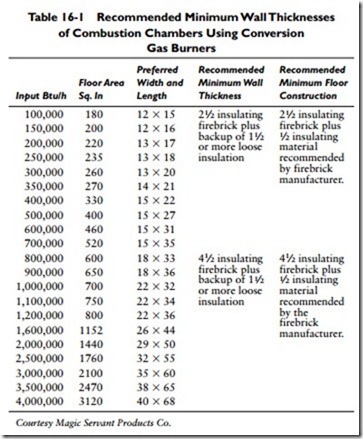Basic Combustion Chamber Requirements
An essential requirement for combustion chambers is that the flame be in the presence of refractory materials so that it will not come into contact with any of the relatively cold heating surfaces of the boiler.
When the flame is burned in suspension in a combustion cham- ber of refractory material, the refractory walls will reflect the heat back into the flame and thereby increase its temperature. This increase in flame temperature due to reflected heat greatly increases the rapidity of combustion and thereby makes possible the burning of every particle of fuel with the zone combustion.
The combustion chamber walls should be high enough so that the flame will not come in contact with the relatively cool walls of the boiler. At the burner end, the refractory wall need not be higher than the grate line of the boiler.
Finally, a well-designed combustion chamber should provide rapid heating at the beginning of each firing cycle.
Combustion Chambers for Conversion Gas Burners
Conversion gas burners are designed for firing into a refractory lined combustion chamber constructed in the ashpit of a boiler or furnace. It is recommended that built-up combustion chambers used for this purpose be constructed of 2300°F insulating firebrick and cemented with insulating firebrick mortar.
Recommended minimum wall thicknesses and floor areas of these combustion chambers are based on the maximum rated Btu capacity (Table 16-1).
The height of combustion chamber walls will usually be deter- mined by the grate line. Build the side and front walls about 2 inches above the grate line. The grate lugs and base of the water legs of boilers should be covered by about 3 or 4 in to avoid heating sections that may be filled with sediment. Carry the back wall one or two brick courses higher than the side or front walls and allow it to overhang in order to deflect hot gases from impingement on the heat exchanger surfaces. Use a hard firebrick for the overhang section, because the high-velocity gases moving against it tend to erode a softer brick.
If the combustion chamber is to be placed directly on the floor of the ashpit, a layer of suitable insulating material or refractory brick recommended by the firebrick manufacturers (1⁄2-in minimum thickness) should underlay the combustion chamber. Ordinary brick may be used in the floor of the combustion chamber. Ordinary brick may be used in the floor of the ashpit. The remaining open space should be filled with vermiculite or some other suit- able loose insulation.
